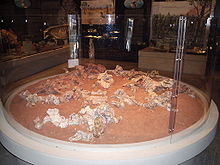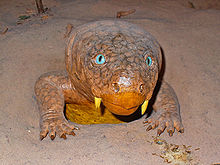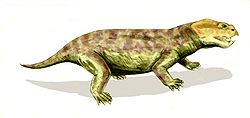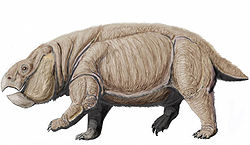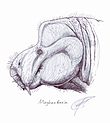- Dicynodont
-
Dicynodonts
Temporal range: 268–105 Ma Middle Permian to Early Cretaceous[1]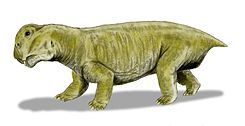
Lystrosaurus, one of few genera of dicynodonts that survived the Permian-Triassic extinction event. Scientific classification 
Kingdom: Animalia Phylum: Chordata Class: Synapsida Order: Therapsida clade: †Chainosauria Infraorder: †Dicynodontia
Owen, 1859Clades & Genera see "Taxonomy"
Dicynodontia is a taxon of anomodont therapsids or mammal-like reptiles. Dicynodonts were small to large herbivorous animals with two tusks, hence their name, which means 'two dog tooth'. They are also the most successful and diverse of the non-mammalian therapsids, with over 70 genera known, varying from rat- to ox-sized.
Contents
Characteristics
The dicynodont skull is highly specialised; light but strong, with the synapsid temporal openings at the rear of the skull are greatly enlarged, to accommodate larger jaw muscles. The front of the skull and the lower jaw are generally narrow and, in all but a number of primitive forms, toothless. Instead, the front of the mouth is equipped with a horny beak, as in turtles and ceratopsian dinosaurs. Food was processed through retraction of the lower jaw when the mouth closed, producing a powerful shearing action (Crompton and Hotton 1967), which would have enabled dicynodonts to cope with tough plant material. Many genera also have a pair of tusks, which it is thought may have been an example of sexual dimorphism (Colbert 1969 p.137)
The body is short, strong and barrel-shaped, with strong limbs. In large genera (such as Dinodontosaurus) the hindlimbs were held erect, but the forelimbs bent at the elbow. Both the pectoral girdle and the ilium are large and strong. The tail is short.
Evolutionary history
Dicynodonts first appear during Middle Permian, and underwent a rapid evolutionary radiation, becoming the most successful and abundant land vertebrates of the Late Permian. During this time they included a large variety of ecotypes, including large, medium-sized, and small herbivores and short-limbed mole-like burrowers.
Only two families survived the end Permian extinction, one of which, the Lystrosauridae, were the most common and widespread herbivores of the Induan (earliest Triassic). These medium-sized animals evolved into and were replaced by the Kannemeyeridae, stocky, pig- to ox-sized animals that were the most abundant herbivores worldwide from the Olenekian to the Ladinian age. By the Carnian they had been supplanted by traversodont cynodonts and rhynchosaur reptiles. During the Norian (middle of the Late Triassic), perhaps due to increasing aridity, they drastically declined, and the role of large herbivore was taken over by sauropodomorph dinosaurs.
With the decline and extinction of the kannemeyerids, there were to be no more dominant large synapsid herbivores until the middle Paleocene epoch (60 Ma) when mammals, descendants of cynodonts, began to diversify after the extinction of the dinosaurs.
It used to be thought that dicynodonts died out completely before the end of the Triassic. Recently however, evidence has come to light showing the dicynodonts survived into the Cretaceous in southern Gondwana[1] (now Queensland) (Thulborn and Turner, 2003). Recent studies give that this fossil belongs to crocodylomorph like Baurusuchus.
Systematics
Taxonomy
Dicynodontia was originally named by English paleontologist Richard Owen. It was erected as a family of the order Anomodontia and included the genera Dicynodon and Ptychognathus. Other families of Anomodontia included Gnathodontia, which included Rhynchosaurus (now known to be an archosauromorph) and Cryptodontia, which included Oudenodon. Cryptodonts were distinguished from dicynodonts from their absence of tusks. Although it lacks tusks, Oudenodon is now classified as a dicynodont, and the name Cryptodontia is no longer used. Thomas Henry Huxley revised Owen's Dicynodontia as an order that included Dicynodon and Oudenodon.[2] Dicynodontia was later ranked as a suborder or infraorder with the larger group Anomodontia, which is classified as an order. The ranking of Dicynodontia has varied in recent studies, with Ivakhnenko (2008) considering it a suborder, Ivanchnenko (2008) considering it an infraorder, and Kurkin (2010) considering it an order.[3]
Many higher taxa, including infraorders and families, have been erected as a means of classifying the large number of dicynodont species. Cluver and King (1983) recognized several main groups within Dicynodontia, including Diictodontia, Endothiodontia, Eodicynodontia, Kingoriamorpha, Pristerodontia, and Venjukoviamorpha.[4] Many families have been proposed, including Cistecephalidae, Diictodontidae, Dicynodontidae, Emydopidae, Endothiodontidae, Kannemeyeriidae, Kingoriidae, Lystrosauridae, Myosauridae, Oudenodontidae, Pristerodontidae, and Robertiidae. However, with the rise of phylogenetics, most of these taxa are no longer considered valid. Kammerer and Angielczyk (2009) suggested that the problematic taxonomy and nomenclature of Dicynodontia and other groups results from the large number of conflicting studies and the tendency for invalid names to be mistakenly established.[5]
- Infraorder Dicynodontia
- Genus Angonisaurus
- Genus Colobodectes
- Superfamily Eodicynodontoidea
- Family Eodicynodontidae
- Superfamily Kingorioidea
- Family Kingoriidae
- Genus Kingoria
- Genus Kombuisia
- Family Kingoriidae
- Clade Diictodontia
- Superfamily Emydopoidea
- Family Cistecephalidae
- Family Emydopidae
- Genus Myosauroides
- Genus Myosaurus
- Genus Palemydops
- Superfamily Robertoidea
- Superfamily Emydopoidea
- Clade Pristerodontia
- Genus Dinanomodon
- Genus Odontocyclops
- Genus Propelanomodon
- Family Aulacocephalodontidae
- Family Dicynodontidae
- Genus Dicynodon
- Family Lystrosauridae
- Genus Kwazulusaurus
- Genus Lystrosaurus
- Family Oudenodontidae
- Family Pristerodontidae
- Superfamily Kannemeyeriiformes
- Family Kannemeyeriidae
- Genus Dinodontosaurus
- Genus Dolichuranus
- Genus Ischigualastia
- Genus Kannemeyeria
- Genus Placerias
- Genus Rabidosaurus
- Genus Sinokannemeyeria
- Family Shansiodontidae
- Family Stahleckeriidae
- Family Kannemeyeriidae
Unknown placement:
- Genus Moghreberia
- Genus Wadiasaurus
Phylogeny
Below is a cladogram modified from Angielczyk and Rubidge (2010) showing the phylogenetic relationships of Dicynodontia:[6]
Dicynodontia Lanthanostegus
Pylaecephalidae Prosictodon
Pristerodon
Emydopoidea Kingoriidae Kombuisia
Cistecephalidae Kawingasaurus
Pristerodontia Interpresosaurus
Elph
Cryptodontidae Tropidostoma
Geikiidae Idelesaurus
Aulacephalodon
Geikia
Pelanomodon
Dicynodontoidea Katumbia
Lystrosauridae
Kannemeyeriiformes
Vivaxosaurus
See also
References
- ^ a b *Thulborn, T. & Turner, S. 2003. The last dicynodont: an Australian Cretaceous relict. Proceedings of the Royal Society of London B 270, 985-993. Abstract.
- ^ Osborn, H.F. (1904). "Reclassification of the Reptilia". The American Naturalist 38 (446): 93–115. doi:10.1086/278383. http://books.google.com/books?id=EHMWAAAAYAAJ&printsec=frontcover#v=onepage&q&f=false.
- ^ Kurkin, A.A. (2010). "Late Permian dicynodonts of Eastern Europe". Paleontological Journal 44 (6): 72–80.
- ^ Cluver, M.A.; and King, G.M. (1983). "A reassessment of the relationships of Permian Dicynodontia (Reptilia, Therapsida) and a new classification of dicynodont". Annals of the South African Museum 91: 195–273.
- ^ Kammerer, C.F.; and Angielczyk, K.D. (2009). "A proposed higher taxonomy of anomodont therapsids". Zootaxa 2018: 1–24. http://www.mapress.com/zootaxa/2009/f/z02018p024f.pdf.
- ^ Kenneth D. Angielczyk; Bruce S. Rubidge (2010). "A new pylaecephalid dicynodont (Therapsida, Anomodontia) from the Tapinocephalus Assemblage Zone, Karoo Basin, Middle Permian of South Africa". Journal of Vertebrate Paleontology 30 (5): 1396–1409. doi:10.1080/02724634.2010.501447. http://www.informaworld.com/smpp/content~db=all~content=a926992136~frm=titlelink.
- Carroll, R. L. (1988), Vertebrate Paleontology and Evolution, WH Freeman & Co.
- Colbert, E. H., (1969), Evolution of the Vertebrates, John Wiley & Sons Inc (2nd ed.)
- Cox, B., Savage, R.J.G., Gardiner, B., Harrison, C. and Palmer, D. (1988) The Marshall illustrated encyclopedia of dinosaurs & prehistoric animals, 2nd Edition, Marshall Publishing
- Crompton, A. W, and Hotton, N. 1967. Functional morphology of the masticatory apparatus of two dicynodonts (Reptilia, Therapsida). Postilla, 109:1–51.
- King, Gillian M., "Anomodontia" Part 17 C, Encyclopedia of Paleoherpetology, Gutsav Fischer Verlag, Stuttgart and New York, 1988
- -- -- , 1990, the Dicynodonts: A Study in Palaeobiology, Chapman and Hall, London and New York
- Thulborn, Tony and Turner, Susan, 2003, "The last dicynodont: an Australian Cretaceous relict" Proceedings: Biological Sciences Vol 270, No 1518 / May 7, 2003; pp 985 - 993
External links
Kingdom: Animalia · Phylum: Chordata · Class: Synapsida · Order: Therapsida Basal therapsids Eutherapsida DicynodontiaEutheriodontiaMammaliaRelated categories Synapsids · TherapsidsCategories:- Dicynodonts
- Infraorder Dicynodontia
Wikimedia Foundation. 2010.

